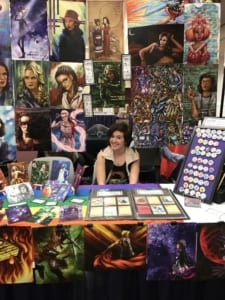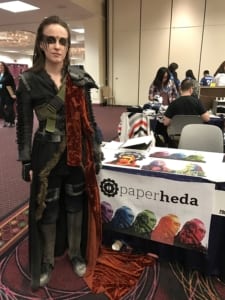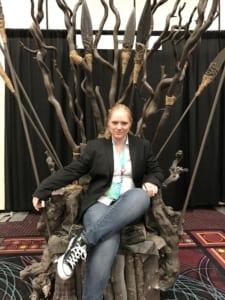So, ClexaCon has come and gone. It almost feels like a surreal dream in some ways, because it was too perfect to have been real. For a first time convention, it was an absolutely resounding success, and one of the most incredible experiences of my life. So what made it such a brilliant experience? Well, you can hear my co-editor Gretchen and I gush about the celebrity guests here on our Ladies First podcast, but it was far more than autographs and photographs with your heroes.

If there’s one thing that truly defines femslash as a fandom, it’s the awe inspiring, dizzying amount of fan content we create for the characters and shows that we love. From 100,000+ word fanfiction works, to fullsize oil paintings by classically trained artists, to elaborate cosplays, and more, the femslash fandom is a notoriously hardworking, creative, and talented one. While it’s not unheard of for femslash artists to attend more general fan conventions, never in my life have I seen so many different femslash artists all in one place. It’s one thing to see the works of J. Foley or Pixelwayve (left) all over your Tumblr dash, it’s quite another to see them in person, in the same place, surrounded by dozens of artists like them.
The variety available from booth to booth was quite impressive, both in how many different fandoms were represented and the number of artistic styles on display. During my three days at the convention, I saw everything from pencil rendering, to oil painting, to woodcut, to papercraft, to digital art, to textile crafts. Artists were eager to gush with you about fandom, and to talk about what creating the art means to them. The passion was very palpable in a way I’ve never really experienced at a fandom convention, or even most art conventions.

The act of creating femslash fanart is about far more than just making a living off of your work. It’s something deeply personal to each artist, and something that is not really done in the spirit of turning a profit. It can be a form of therapy, especially since femslash shipping often involves the pain and suffering of both the characters and the fandom. There are projects like Paper Heda (right) that started as a way to cope with the loss of Lexa, and to heal from it. Several of the artists I spoke to brought this up on their own, citing its importance to both them and the people who enjoy their work. Femslash fanart is about more than just mindless self indulgence; it’s about building a community that feels and heals together.
It was also very inspiring to see that most, if not all, the artists featured were women, with a wide variety of educational backgrounds and ages. It’s a common stereotype that art is a feminine thing, but it’s no secret that the bulk of production art like comic books, animation, and concept art is created by men. How unfriendly a particular artistic industry is to women varies greatly across disciplines, but every woman who has ever done professional art has encountered pushback because of her gender in one way or another. Sometimes it’s in the narratives we choose to tell in our art, sometimes it’s the fact that our art style is perceived to be inferior because it is somehow “feminine,” and sometimes it’s just a big, heaping spoonful of old fashioned sexism. When going into a discipline like art that is already very emotionally and physically demanding, butting heads against sexist art critics and creative directors is even more of an emotional burden to carry, and it’s one you’re expected to carry with a smile on your face.

Every single person who grows up investing the hard work it takes to get good at art is told their entire life, “it’s so hard to make a living at this.” Variations include, “it’s very competitive,” “the work isn’t stable,” and the coup de grace, “why don’t you get a real job?” The thing is, everyone who does art is fully aware of how difficult it is, even if we didn’t spend our whole lives surrounded by concerned parents, teachers, and guidance counselors constantly hammering that message into our heads. It’s somewhat ironic, considering that we are also constantly hammered with the message that you should “do what you love,” “get a job that you’re passionate about,” and “find your bliss.” But it is possible to make a living at art, even if it is hard. Several of the artists I spoke to worked in the animation, video games, and comic book industries, and most of them told me that while it was stressful and unstable, they do it because they wouldn’t be happy doing anything else. It’s a noble, inspiring, and deeply defiant attitude to have. Especially for a woman.
There were a lot of inspiring things to take away from ClexaCon 2017 as a convention and as an experience. Many of the panel contributors and press members were very young women, or women in their late 20’s and early 30’s like myself and Gretchen who are just now hitting the ground running. The celebrity guests were incredibly gracious and kind, and you could tell how deeply every single one of them cared about the responsibility they have to the community they represent. But what struck me the most was, for the first time, being physically surrounded by my peers and allies in a real-life space. ClexaCon was Tumblr fandom personified and brought to life before your eyes, uniting all femslash fans across shipping war lines and between fandoms or mediums. This convention was something by us, for us, created for our enjoyment and consumption, and nothing drove that point home harder than the fanart.
If you didn’t attend the convention yourself, you’ll just have to take my word for it that it was awesome. But you can always show your support for the community. If you can, put your money where your mouth is: fanartists do sell their work, and if you can, you really should buy some. It was a privilege to see all of these artists inflate with happiness and pride when people told them how much they loved their work. But if we want them to keep providing us with amazing content, we need to make sure they are earning what they deserve for all the wonderful work they give us. Support your local femslash fandom artist any way you can.
Finally, if you’ll permit me, I’d like to give some closing thoughts on the convention itself. What I personally got from this convention, other than well over $200 in art, was a reminder that the people in the online femslash communities are real. When so much of your community is relegated to online spaces, for practicality and our personal safety, it’s easy to start to feel isolated. You forget that there are real people behind those blogs, who have full and rich lives outside of whatever fandom they’re currently spamming their followers with in a wave of femslash excitement. I met people from at least ten different countries. I learned from women who are old enough to be my mother or grandmother who have been in the trenches of femslash shipping since before I was born. I got to tell Heather Hogan in person that she was the one who inspired me to write about queer media, and she shook my hand. I now know exactly how much taller Kat Barrell is than I am, both in heels and in flats. Every corner of this convention was bursting with the message, “you are valid,” and that was a message that I really needed to hear.

Anyway, that’s enough sap from me. See you next year ClexaCon, we can’t wait to see what you’ve got in store for us next!


